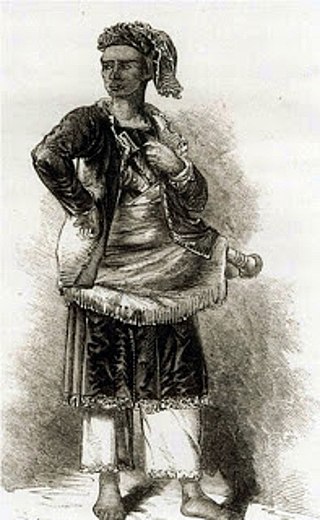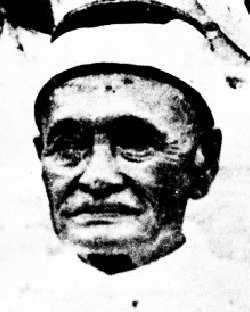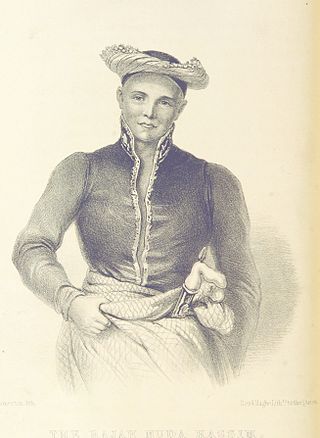Related Research Articles

Kuching, officially the City of Kuching, is the capital and the most populous city in the state of Sarawak in Malaysia. It is also the capital of Kuching Division. The city is on the Sarawak River at the southwest tip of Sarawak on the island of Borneo and covers an area of 431 km2 (166 sq mi) with a population about 165,642 in the Kuching North administrative region and 159,490 in the Kuching South administrative region—a total of 325,132 people.
The Malay language has a complex system of styles, titles and honorifics which are used extensively in Brunei Darussalam, Malaysia and Singapore.

Omar Ali Saifuddin II was the 23rd Sultan of Brunei. During his reign, Western powers such as the United Kingdom and the United States visited the country. His reign saw the British adventurer James Brooke becoming the White Rajah of Sarawak.

Ahmad Tajuddin Akhazul Khairi Waddien was the 27th Sultan of Brunei from 1924 until his death in 1950. He was succeeded by his younger brother Sultan Omar Ali Saifuddien III.
Abang Openg bin Abang Sapiee was a Malaysian politician who served as the first Yang di-Pertua Negeri of Sarawak from September 1963 to his death in March 1969. He assumed the newly established post following Sarawak's independence from Great Britain and the formation of Malaysia in 1963. He is the father to Abang Abdul Rahman Zohari Abang Openg, the current Premier of Sarawak.

Sultan 'Abdul Momin was the 24th Sultan of Brunei from 1852 until his death in 1885.

The Raj of Sarawak, also the Kingdom of Sarawak or State of Sarawak, located in the northwestern part of the island of Borneo, was an independent state founded in 1841, in a treaty of protection with the United Kingdom starting from 1888. It was established from a series of land concessions acquired by an Englishman, James Brooke, from the Sultan of Brunei. Sarawak was recognised as an independent sovereign state by the United States in 1850 and by the United Kingdom in 1864. The Kingdom is now the Malaysian state of Sarawak.

Datu Patinggi Abang Haji Abdillah College, colloquially referred to as Abdillah College, is an elite coeducational day and boarding secondary school located in Kuching, Sarawak, Malaysia. The school is a national secondary school, a government school in which Malay is the main medium of instruction.

Datu Patinggi Abang Haji Abdillah was a Malaysian politician in Sarawak who participated in the movement opposing cessation to the British Empire. He was the son of Datu Bandar Abang Haji Mohammad Kassim; who served as mayor of Kuching under the White Rajah's administration. He was also the grandson of Datu Bandar Abang Haji Bolhassan and a descendant of Datu Patinggi Ali who fought to achieve Sarawak's independence from Brunei. After the death of his father in Mecca, in 1921, he was given the title Datu Muda. In 1924, he became the Datu Bandar and then in 1937 he was given the title Datu Patinggi.
Syarif Masahor bin Syarif Hassan, also written as Sharif Masahor was a famous Malay rebel of Hadhrami descent in Sarikei, Sarawak state, Malaysia during the Brooke White Rajahs era in that state.

The History of Sarawak can be traced as far as 40,000 years ago to the paleolithic period where the earliest evidence of human settlement is found in the Niah caves. A series of Chinese ceramics dated from the 8th to 13th century AD was uncovered at the archeological site of Santubong. The coastal regions of Sarawak came under the influence of the Bruneian Empire in the 16th century. In 1839, James Brooke, a British explorer, first arrived in Sarawak. Sarawak was later governed by the Brooke family between 1841 and 1946. During World War II, it was occupied by the Japanese for three years. After the war, the last White Rajah, Charles Vyner Brooke, ceded Sarawak to Britain, and in 1946 it became a British Crown Colony. On 22 July 1963, Sarawak was granted self-government by the British. Following this, it became one of the founding members of the Federation of Malaysia, established on 16 September 1963. However, the federation was opposed by Indonesia, and this led to the three-year Indonesia–Malaysia confrontation. From 1960 to 1990, Sarawak experienced a communist insurgency.
Tuanku Bujang bin Tuanku Othman was a Malaysian politician who served as the 2nd Yang di-Pertua Negeri (Governor) of Sarawak from 1969 to 1977.
The Darjah Yang Amat Mulia Bintang Kenyalang Sarawak is the second highest order group of the orders, decorations, and medals of Sarawak. The order was instituted in 1970, and was redesigned in 1988. Two more ranks were added to the order: the 'Officer' in 1988 and the 'Companion' in 2002.
The Samariang Muslim Cemetery is the largest Muslim cemetery in Kuching city, Sarawak, Malaysia. It is located near Kampung Samariang near Petra Jaya. It is the final resting place of many prominent Malay Sarawakian personalities.
Liu Shan Bang was a Chinese gold miner in Bau, Sarawak. He was best known as the leader of the 1857 Chinese Uprising against the White Rajah James Brooke.
Sultan Ibrahim Ali Omar Shah Ibni Sultan Muhammad Hassan Ibni Sultan Saiful Rijal Ibni Sultan Abdul Kahar Ibni Sultan Bolkiah Ibni Sultan Sulaiman Ibni Sultan Sharif Ali Barakat, also known as Sultan Tengah Manga. He was born with the title of Pengiran Raja Tengah and was the first and only ruler of the Sultanate of Sarawak.

The Sultanate of Sarawak was a Malay kingdom, located in present-day Kuching Division, Sarawak. The kingdom was founded in 1599, after the conquest of the preceding Santubong Kingdom and the later Sultanate of Brunei.

Edge of the World is a 2021 adventure drama film directed by Michael Haussman and starring Jonathan Rhys Meyers as the British soldier and adventurer James Brooke (1803–1868), the first White Rajah of Sarawak. The film also features Atiqah Hasiholan, Dominic Monaghan, Hannah New, and Josie Ho. The script was written by Rob Allyn, who also produced the film. Edge of the World is a co-production between Malaysia, China, the US and the UK.

Pengiran Mohammad Salleh (1790s–1858) or commonly referred to by his title Pengiran Indera Mahkota, was a Bruneian nobleman and politician who was governor of Sarawak in 1827. In the region that is now part of Sarawak, he founded the city of Kuching in 1827.
Prince Hashim of Brunei or commonly referred to by his title Pengiran Muda Hashim and Raja Muda Hashim, was a Bruneian prince who was the son of Sultan Muhammad Kanzul Alam, and uncle to Sultan Omar Ali Saifuddin II.
References
- 1 2 3 Haslina Bujang (16 September 2017). "Tokoh Nasionalisme Melayu Sarawak Sepanjang Zaman". thepatriots.asia (in Malay). Retrieved 6 January 2024.
- 1 2 3 4 "A portrait of Datu Patinggi Ali". www.brooketrust.org. 13 April 2016. Retrieved 5 January 2024.
- ↑ "Sarawak Before 1841". sarawak.gov.my. Retrieved 5 January 2024.
- 1 2 3 4 5 6 "Gelaran Datu bermula zaman Brooke". www.utusansarawak.com.my (in Malay). 1 November 2022. Retrieved 5 January 2024.
- ↑ Mohd Hasbie Sulaiman (Haji) (1989). Perjuangan anti-cession Sarawak: peranan utama Persatuan Kebangsaan Melayu Sarawak (in Malay). PGI Cipta. p. 15. ISBN 978-983-99640-0-4.
- 1 2 Our Sarawak. Persatuan Kesusasteraan Sarawak. 1983. p. 37.
- ↑ Mohamad Faizal Jamil (2007). Katarsis perjuangan (in Malay). Dewan Bahasa dan Pustaka. p. 46. ISBN 978-983-62-9695-5.
- ↑ Pat Foh Chang (1997). Heroes of the Land of Hornbill. Chang Pat Foh. ISBN 978-983-9475-04-3.
- ↑ Pat Foh Chang (1997). Heroes of the Land of Hornbill. Chang Pat Foh. ISBN 978-983-9475-04-3.
- ↑ Alex Ling (2013). GOLDEN DREAMS OF BORNEO. Xlibris Corporation. p. 301. ISBN 978-1-4797-9168-2.
- ↑ Ooi Keat Gin; Victor T. King (29 July 2022). Routledge Handbook of Contemporary Brunei. Taylor & Francis. ISBN 978-1-000-56864-6.
- ↑ Marie-Sybille de Vienne (9 March 2015). Brunei: From the Age of Commerce to the 21st Century. NUS Press. p. 77. ISBN 978-9971-69-818-8.
- ↑ Pat Foh Chang (1995). The Land of Freedom Fighters. Ministry of Social Development.
- ↑ Alice Yen Ho (1998). Old Kuching. Oxford University Press. p. 2. ISBN 978-983-56-0050-0.
- 1 2 3 4 5 Lawrence Law (2020). PERANG MENENTANG KESULTANAN BRUNEI DI BAU PADA ABAD KE-19 (PDF) (in Malay). Institut Pendidikan Guru Kampus Batu Lintang.
- 1 2 JOANNA YAP (3 April 2016). "Tracing influence of Brunei and Sambas in formation of S'wak". www.theborneopost.com. Retrieved 5 January 2024.
- ↑ Pat Foh Chang (1997). Heroes of the Land of Hornbill. Chang Pat Foh. ISBN 978-983-9475-04-3.
- ↑ Pat Foh Chang (1995). The Land of Freedom Fighters. Ministry of Social Development.
- ↑ William L. S. Barrett (1988). Brunei and Nusantara History in Coinage. Brunei History Centre. p. 229.
- ↑ Sir James Brooke (1853). The Private Letters of Sir James Brooke, K.C.B., Rajah of Sarawak, Narrating the Events of His Life, from 1838 to the Present Time. R. Bentley. p. 243.
- ↑ Faisal S. Hazis (1 August 2003). Domination and Contestation. Flipside Digital Content Company Inc. ISBN 978-981-4515-52-8.
- ↑ Jais Sahok (2013). SEBUAH KUMPULAN DRAMA PENTAS DARI BUMI SARAWAK LIBAU RENTAP; BUKAN PENYERAHAN (in Malay). ITBM. p. 391. ISBN 978-967-430-307-5.
- ↑ Pat Foh Chang (1997). Heroes of the Land of Hornbill. Chang Pat Foh. ISBN 978-983-9475-04-3.
- ↑ "5 interesting things to know about Datu Patinggi Abdul Gapor". kajomag.com (in Malay). 3 July 2018. Retrieved 6 January 2024.
- ↑ "Sejarah RB". w8dbak.com (in Malay). Retrieved 5 January 2024.
- ↑ "Beting Patinggi Ali milik Malaysia, tidak iktiraf sebarang tuntutan". www.astroawani.com (in Malay). 27 January 2023. Retrieved 5 January 2024.
- ↑ Pat Foh Chang (1997). Heroes of the Land of Hornbill. Chang Pat Foh. ISBN 978-983-9475-04-3.